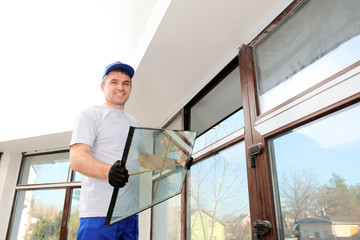If you are looking to upgrade your windows, choose a new window style with the right features for appearance, structural stability, and energy efficiency. Also, consider the price of the windows and look for financing options.
There are two types of replacement windows: full frame and pocket. While full-frame replacements require the removal of exterior cladding and trim, pocket replacements leave the original frame in place. For professional help, contact Window Replacement Massachusetts.
Window frames are often susceptible to moisture due to their role as intermediaries between the outside elements and your home’s interior. When wood around a window becomes damp, it can cause the frame to warp, bow or even rot. When this happens, the structural integrity of the window is compromised, and if left unchecked, the problem may spread to nearby bricks and shingles or even into your home’s interior walls. If the rotting extends to any of these areas, it’s likely time to call in professional help for a full home window replacement.
The signs of a window frame with serious rot are not hard to spot, and the best way to assess the extent of the damage is to use a screwdriver or chisel to feel around the corners of the window. Any area of the frame that feels soft or spongy is probably infested with dry rot, a type of fungus that thrives on damp wood and will continue to deteriorate if not treated quickly.
If the rot is limited to a small area of the frame or confined to just one corner, it might be possible to repair it. This may involve splicing in fresh timber, but care should be taken to ensure that the new material is shaped and fitted to match the existing profiles of the wood so that the repairs are as durable as possible.
However, if the rot is widespread and/or affecting more than just one corner of the window, it might be more cost-effective and convenient to simply replace the entire frame and window. This can improve the energy efficiency of your home and also provide an opportunity to upgrade to more environmentally-friendly windows.
Even when a window replacement is necessary, it’s important to remember that proper maintenance and annual inspections can greatly extend the life of a window and reduce maintenance needs and costs. If your old window is still in good condition and you’re looking to save money, consider upgrading to a more energy-efficient option that will also help to boost your home’s curb appeal.
Muntins & Mullions
The terms muntin and mullion can often get confused since they sound similar, but they have very different purposes. Muntins are the vertical dividers that separate glass panes in a window, while mullions are the horizontal bars that connect the individual windows or lites.
In older houses, mullions were necessary to support the weight of larger windows, especially in taller or wider wall openings. But today, window manufacturers can create uninterrupted glass units that offer superior energy efficiency without the need for mullions. When shopping for replacement windows, it’s important to consider your desired aesthetic and the architectural style of your home.
Depending on your goals, you may find that modern muntins or “grids” work better for your needs. These modern versions of muntins are not as decorative as traditional ones, and they actually do not separate the glass into individual lites. They attach to the glass and offer an appearance that is similar to traditional multi-pane windows, but provide superior insulation and energy efficiency.
Traditional mullions, on the other hand, are often used for their historical accuracy or to achieve a particular look. They can add a classic or elegant touch to your home and are ideal for Craftsman-style homes, Victorian-style houses, classic/modern farmhouses, and many other historic house styles.
Both muntins and mullions come in several different patterns, so they can match your home’s architecture, window types, or personal decorating preferences. Choose from traditional grid designs for Colonial-style homes, arched mullions to complement curved or arched windows in Victorian houses, or simple, chunky muntins to suit modern or farmhouse decor.
If you have a broken muntin or mullion inside your window, it is not only an aesthetic problem but also a safety concern. If it’s not replaced, the occupant of your home could fall through the gap created by the missing muntin or mullion. Also, the deterioration of the internal muntin or mullion can lead to damage to surrounding materials such as the housing siding and insulation. If this occurs, you may need to replace the entire window.
Chipped or Peeling Paint
When paint starts chipping or peeling, it’s time for a new coat. It’s a normal part of the wear and tear on any painted surface in a house and it’s also a good indicator that it’s reached the end of its useful life.
Window frames are in close proximity to the weather, so they can take a beating over time. Indoors, the paint may start to deteriorate from exposure to sun and moisture, and on the outside, rain and snow are constant threats. This natural wear and tear is a common reason for painting a window frame again.
Another cause of peeling paint is poor application. It’s important to follow the manufacturer’s recommended temperature and application conditions for the best results. When the paint is applied too hot or in direct sunlight, it can blister and lose adhesion. Also, if the wood is not completely dry before the paint is applied, it can push out the paint as it dries, causing bubbles and peeling.
If the paint is peeling back to the previous layer or even plaster, then there’s a serious issue that needs to be addressed before you attempt to repaint. You may have an unstable’mist coat’, chalky contract matt or exposed PVA from the plastering process that has failed and is pulling the new coat away from the wall.
The most common reason that paint begins to peel is because of moisture. Whether it’s condensation on the inside or rain and snow on the outside, moisture seeps into the paint film and then evaporates later. As it evaporates, the pressure from underneath the paint causes the top coat to fail and pull away.
One other consideration that can lead to paint failure is the presence of lead. If your home was built before 1978, the paint on the windows, frames and walls may contain lead that is harmful to adults and children. It’s essential that any contractor you hire to work on your window replacement has the proper certifications and follows EPA regulations. In most cases, encapsulating the lead rather than removing it is the safest option.
Water Damage
Water damage is one of the most common problems that can affect your home’s windows. It is often caused by leaking or improperly sealed windows or by moisture from the rain or snow. If left untreated, moisture infiltration can lead to wood rot and even structural damage to your home. If you see any signs of water damage around your windows, it’s important to act quickly to stop the problem before it gets worse.
Moisture build-up near a window can be easy to miss because it’s not always obvious. In addition to rotting wood, you may notice dark brown or yellow stains on walls and floors or paint that is peeling or chipping away. In many cases, the discoloration is caused by mold that grows in damp areas. This mold can contribute to poor indoor air quality and even worsen allergy symptoms.
Another sign of moisture infiltration near your windows is a dripping or damp window sill or frame. This can occur if the sealant or caulking has cracked or worn away, allowing rain or snow to enter your home. If the caulking is damaged, replacing it with a fresh coat should stop the leaks.
If the weather is warm, you may also notice a build-up of condensation between the panes of your double-pane window. This can be caused by a leak in the sealant or excessive humidity, but it’s important to address the issue to avoid further damage to your window.
The bottom corners of the window are often a good place to look for signs of water infiltration because this is where most leaks start. The sill of your window should slope away from the wall to allow water to drain properly. If the sill isn’t properly sloped or there are cracks in the flashing, water can build up and eventually leak into your home. You can also examine the exterior cladding and trim at the bottom of your window to see if there are gaps or missing pieces that could let water in. You can also check the drainage holes in the flashing to make sure they aren’t clogged.
